In our previous blog post we had discussed about What is Sharing Rules in Salesforce.In these blog post we discuss about What is Custom Buttons In Salesforce
Contents
- 1 What is Custom Buttons in Salesforce
- 1.1 Introduction to custom button in salesforce:-
- 1.2 Definition and Purpose of Custom Buttons:-
- 1.3 Importance of Custom Buttons in Salesforce:-
- 1.4 How Custom Buttons Enhance Sales Productivity:-
- 1.5 Creating Custom Buttons:-
- 1.6 Automating Repetitive Tasks with Custom Buttons:-
- 1.7 Integrating Custom Buttons with Email and Calendar:-
- 1.8 Leveraging Custom Buttons for Data Management and Reporting:-
- 1.9 Enhancing User Experience with Custom Buttons:-
- 1.10 Measuring the Impact of Custom Buttons:-
- 1.11 Conclusion:-
- 1.12 Frequently Asked Questions:-
What is Custom Buttons in Salesforce
Custom buttons in Salesforce play a vital role in enhancing sales productivity by automating repetitive tasks, improving user experience, and integrating with various sales processes. In this comprehensive guide, we will delve into the definition, purpose, and importance of custom buttons in Salesforce, as well as provide a step-by-step guide on creating and utilizing custom buttons effectively.
Definition and Purpose of Custom Buttons:-
Custom buttons in Salesforce are clickable shortcuts that execute predefined actions, such as creating a new record, updating fields, or launching a web URL. The primary purpose of custom buttons is to streamline sales processes and improve efficiency by eliminating manual tasks and reducing the time spent on repetitive actions.
Importance of Custom Buttons in Salesforce:-
Custom buttons are essential tools for sales professionals as they can automate tasks, standardize processes, and enhance user experience within the Salesforce platform. By leveraging custom buttons effectively, sales teams can optimize their workflows, increase productivity, and drive better business outcomes.
How Custom Buttons Enhance Sales Productivity:-
Custom buttons enable sales professionals to perform complex actions with a single click, reducing the time spent on tedious manual tasks and allowing more focus on high-value activities. By automating repetitive processes, custom buttons can significantly boost sales productivity and efficiency.
Creating Custom Buttons:-
Step-by-Step Guide: Creating Custom Buttons in Salesforce
-
Log In to Salesforce: Access your Salesforce organization using your credentials.
-
Navigate to Setup:
- Click on your profile picture or initial in the top-right corner.
- Select “Setup” from the dropdown menu.
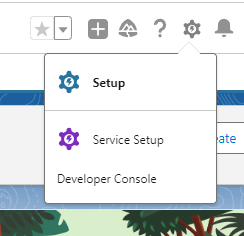
-
Access Object Manager:
- In the Setup menu, type “Object Manager” in the Quick Find box.
- Select “Object Manager” under the Platform Tools section.
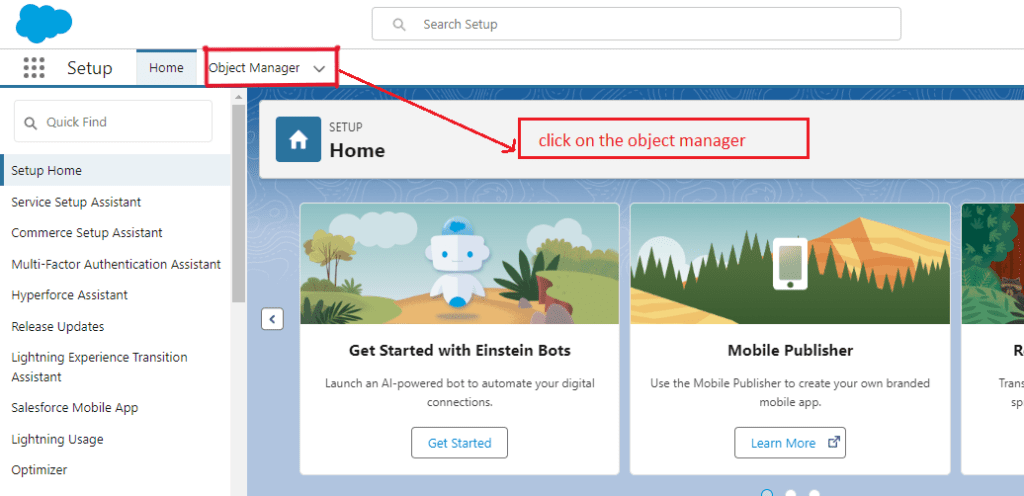
-
Select the Object:
- Locate and click on the Salesforce object (e.g., Account, Opportunity) for which you want to create a custom button.
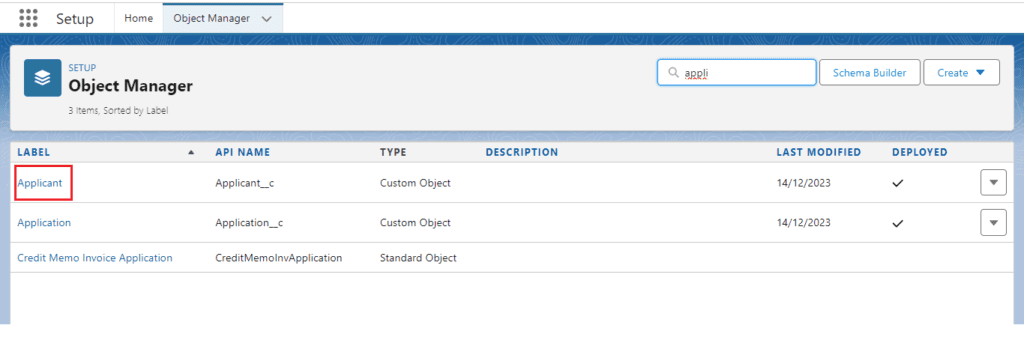
-
Go to Buttons, Links, and Actions:
- Within the selected object management screen, click on “Buttons, Links, and Actions” in the left-hand sidebar.
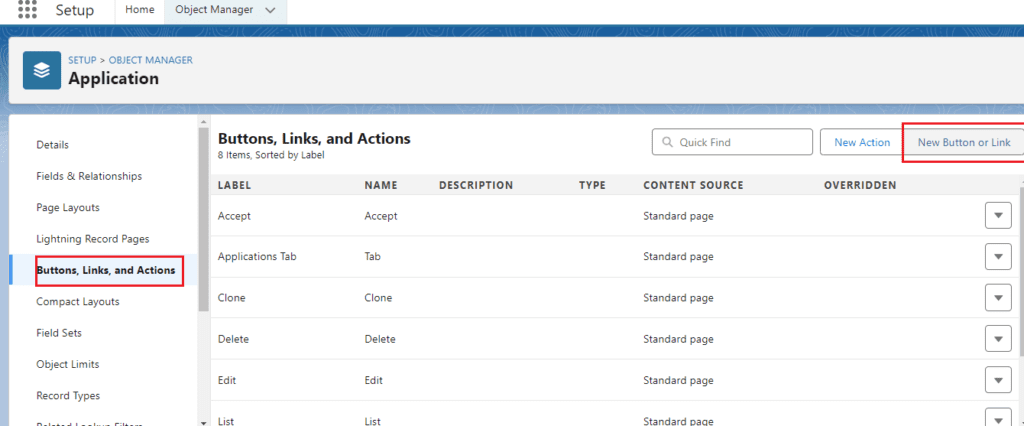
-
Click ‘New Button or Link’:
- Click the “New Button or Link” button to start creating a new custom button.



-
Configure Button Details:
- Button Type: Choose the type of button (e.g., Detail Page Button, List View Button).
- Label: Provide a label for the button (e.g., “Create Task”).
- Name: Automatically generated based on the label.
- Description: Optionally, add a description for the button.
- Display Type: Select how the button should appear (e.g., Button, Link, Detail Page Link).
- Behavior: Define the action when the button is clicked:
- Execute JavaScript
- Display a Visualforce Page
- Redirect to a URL
- Execute Lightning Component
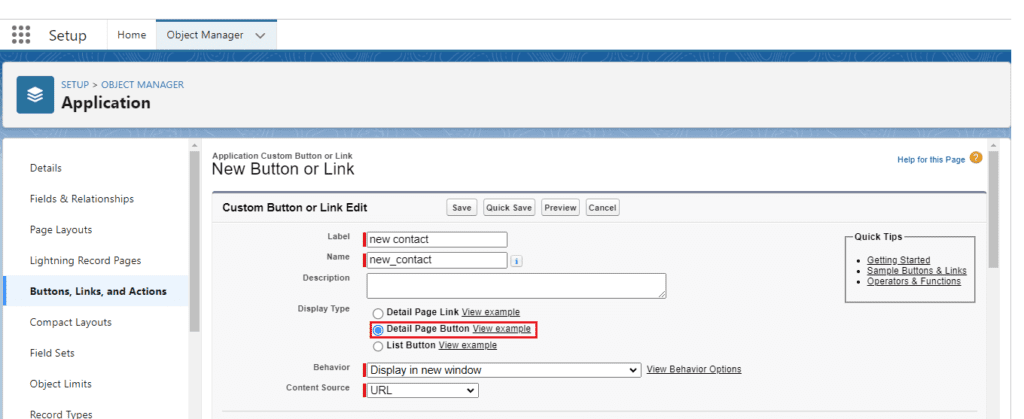



-
Save the Custom Button:
- After configuring the button details and behavior, click “Save” to create the custom button.
Additional Steps (Optional):
-
Add Button to Page Layout:
- Once the custom button is saved, add it to the desired page layouts:
- Edit the relevant page layout for the object.
- Drag and drop the custom button from the “Buttons, Links, and Actions” section onto the desired location on the page layout.
- Save the page layout to apply the custom button.
- Once the custom button is saved, add it to the desired page layouts:
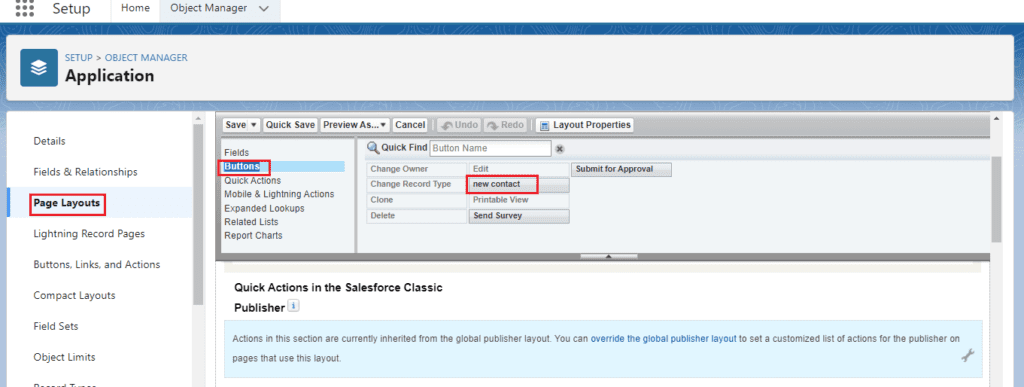

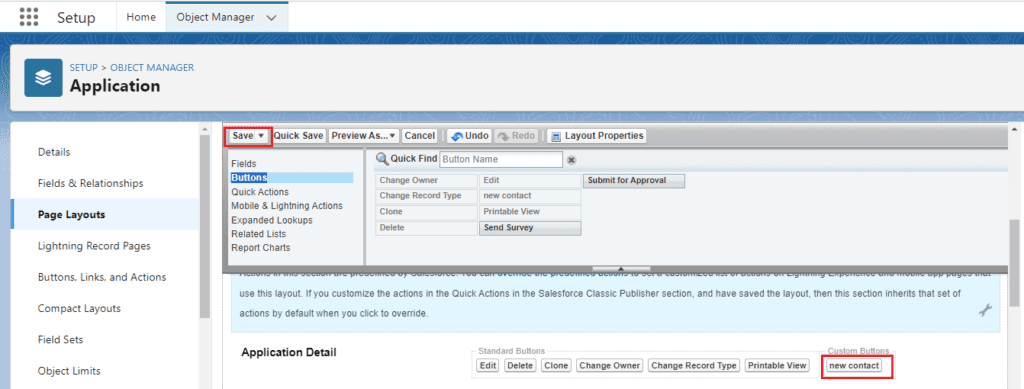

-
Test the Custom Button:
- Navigate to the object’s detail page or list view where the button is added.
- Click on the custom button to test its functionality.
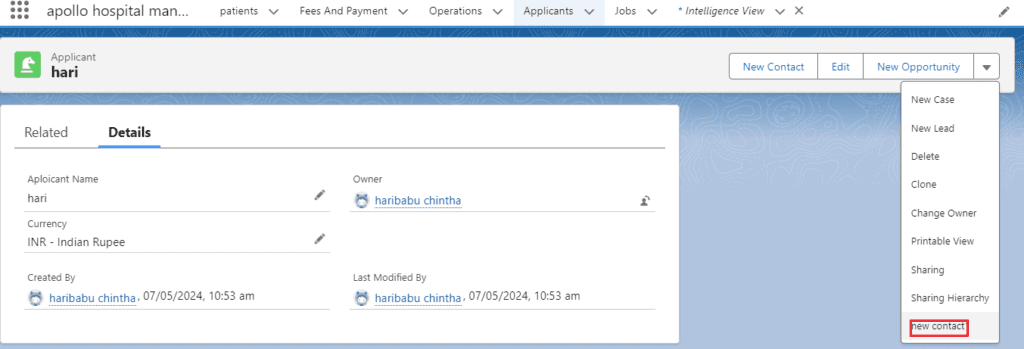

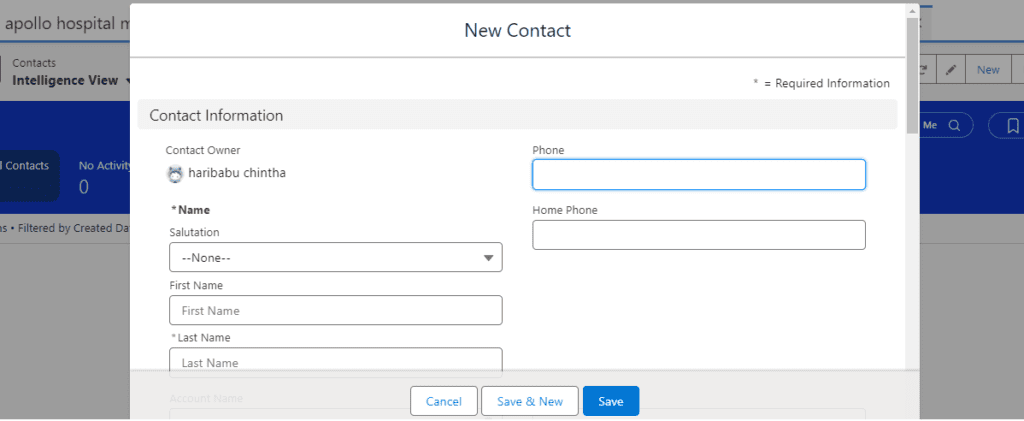

you want know more about What is Custom Buttons in Salesforce click here
Choosing the Right Type of Custom Button:-
Sales professionals can choose from different types of custom buttons in Salesforce, such as Detail Page Buttons, List View Buttons, and Lightning Actions, based on their specific requirements and use cases. It is crucial to select the right type of custom button to ensure optimal functionality and user experience.
Custom Button Best Practices for Sales Teams:-
- Clearly define the purpose of the custom button
- Test the custom button functionality before deployment
- Document the custom button configuration for future reference
- Regularly review and update custom buttons to align with changing business needs
Utilizing Custom Buttons in Sales Processes:-
Automating Repetitive Tasks with Custom Buttons:-
Custom buttons can automate repetitive tasks such as updating fields, creating follow-up tasks, or sending email notifications, freeing sales professionals to focus on more strategic activities like closing deals and building customer relationships.
Integrating Custom Buttons with Email and Calendar:-
Sales teams can integrate custom buttons with email and calendar applications to streamline communication, schedule meetings, and track interactions with prospects and customers more efficiently. Custom buttons can improve collaboration and coordination among team members, leading to better sales outcomes.
Leveraging Custom Buttons for Data Management and Reporting:-
Custom buttons can be used to generate reports, export data, and analyze sales performance within Salesforce. By leveraging custom buttons for data management and reporting, sales professionals can gain valuable insights, identify trends, and make informed decisions to drive business growth.
Enhancing User Experience with Custom Buttons:-
Customizing User Interfaces with Custom Buttons:-
Sales teams can customize user interfaces by adding custom buttons to relevant pages, layouts, and dashboards in Salesforce. By tailoring the user experience with custom buttons, sales professionals can improve navigation, accessibility, and usability within the platform.
Custom buttons can enhance navigation and workflow efficiency by providing quick access to frequently used actions and functions. Sales professionals can streamline their daily tasks, reduce clicks, and navigate seamlessly through Salesforce, leading to a more intuitive and user-friendly experience.
Tailoring Custom Buttons for Mobile Sales Enablement:-
With the increasing trend towards mobile sales enablement, custom buttons can be optimized for use on mobile devices to empower sales professionals on the go. By tailoring custom buttons for mobile accessibility and responsiveness, sales teams can stay productive and connected anytime, anywhere.
Measuring the Impact of Custom Buttons:-
Tracking Performance Metrics with Custom Buttons:-
Sales teams can track performance metrics such as button clicks, conversion rates, and task completion times to assess the effectiveness of custom buttons in streamlining sales processes. By monitoring key performance indicators, sales professionals can identify opportunities for improvement and optimize their use of custom buttons.
Analyzing ROI and Effectiveness of Custom Buttons:-
Measuring the return on investment (ROI) of custom buttons involves evaluating the time savings, productivity gains, and revenue impact generated by utilizing custom buttons in Salesforce. By analyzing the ROI and effectiveness of custom buttons, sales professionals can justify their implementation and make data-driven decisions to drive better business results.
Iterating and Optimizing Custom Buttons for Continuous Improvement:-
To ensure long-term success and maximize the benefits of custom buttons, sales teams should continuously iterate, refine, and optimize their custom button configurations based on feedback, performance data, and evolving business requirements. By embracing a culture of continuous improvement, sales professionals can leverage custom buttons more effectively and adapt to changing market dynamics.
Conclusion:-
In conclusion, custom buttons in Salesforce offer sales professionals a powerful tool to streamline workflows, boost productivity, and drive better business outcomes. By following this comprehensive guide and implementing custom buttons effectively, sales teams can unlock the full potential of Salesforce and achieve success in their sales endeavors.
Key Takeaways for Sales Professionals:-
- Custom buttons automate tasks, standardize processes, and enhance user experience in Salesforce
- Choosing the right type of custom button is crucial for optimal functionality and usability
- Regularly measuring and analyzing the impact of custom buttons is essential for continuous improvement
Next Steps for Implementing Custom Buttons in Your Salesforce Workflow:-
- Identify key processes and tasks that can be automated with custom buttons
- Create a strategy for implementing and integrating custom buttons into your sales processes
- Train team members on how to use custom buttons effectively and provide ongoing support and guidance
Frequently Asked Questions:-
1 .What are the limitations of custom buttons in Salesforce?
While custom buttons offer various benefits, they have limitations such as not being supported in Lightning Experience, limited customization options, and potential security risks if not configured correctly.
2. How can custom buttons be integrated with third-party applications?
Custom buttons can be integrated with third-party applications using Salesforce’s APIs, web services, and external data sources to extend functionality and automate tasks across different platforms.
3. Are there any security considerations to keep in mind when using custom buttons?
It is essential to follow best practices for security, such as limiting access to custom buttons based on user profiles, avoiding hardcoding sensitive information in buttons, and regularly auditing and monitoring custom button usage to prevent unauthorized actions.
By following this comprehensive guide, sales professionals can unlock the full potential of custom buttons in Salesforce to streamline their workflows, boost productivity, and drive better business outcomes.
In our next blog post we will discuss about What is Custom actions in Salesforce

3 thoughts on “What is Custom Buttons in Salesforce”